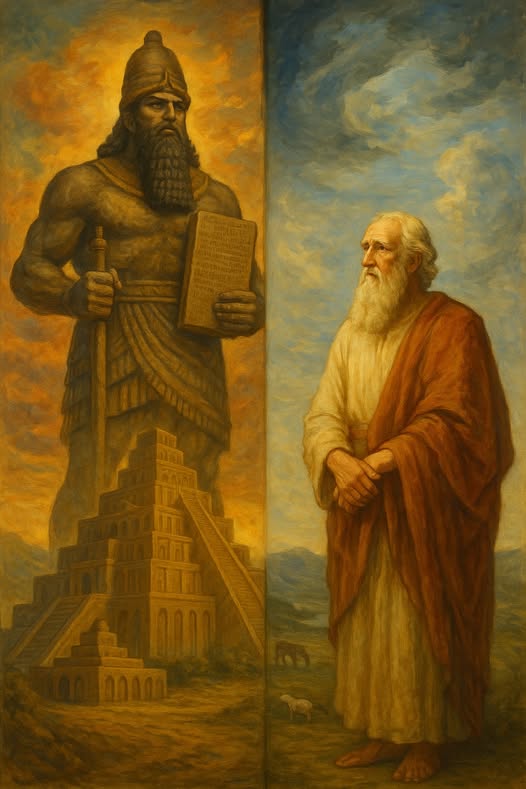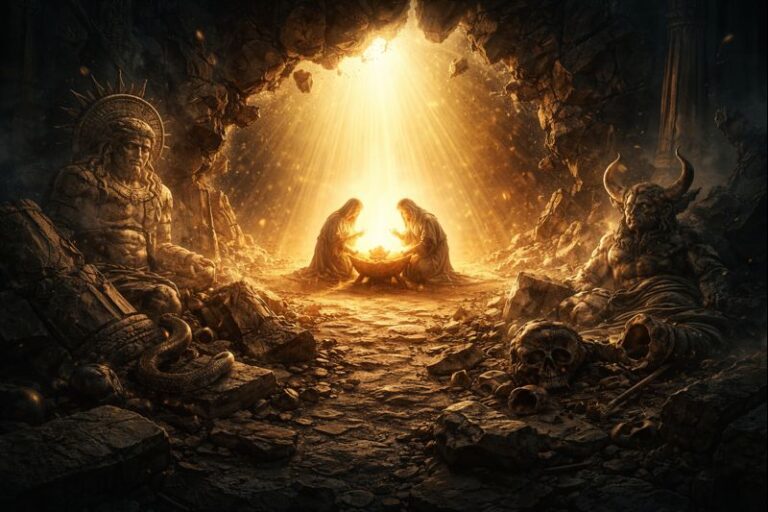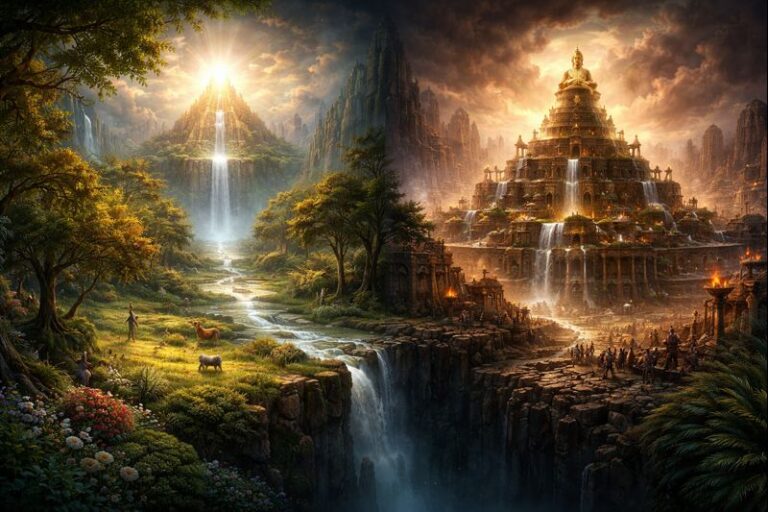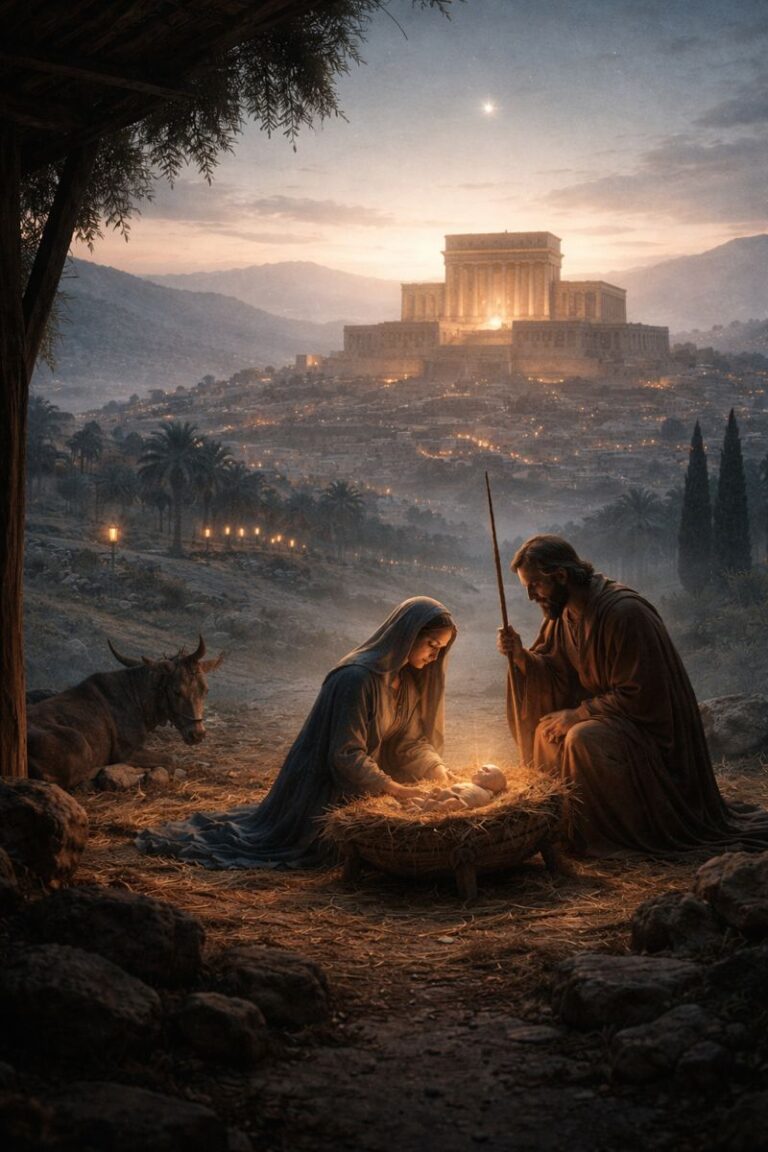
In the earliest layers of Mesopotamian literature, the Sumerian King List stands as a remarkable record of legendary rulers. These kings, beginning with Alulim of Eridu, are said to have reigned for tens of thousands of years. Alulim ruled for 28,800 years, while others such as En-men-lu-ana of Bad-tibira are credited with reigns of 43,200 years. The list presents eight antediluvian kings in total, whose rule was said to have lasted for 241,200 years before the heavens brought a great flood.
These numbers are not historical in the modern sense. They are symbolic and rooted in the Sumerian sacred use of numbers, especially the sexagesimal base-60 system. Lifespans were often structured as multiples of 3,600, a unit known as a sar. The theological point is clear. Kingship was believed to have descended from heaven, and these early rulers were seen not merely as political figures but as mediators between gods and mortals. Their reigns reflect divine favor, cosmic order, and a time when humans stood closer to the divine realm.
The flood marks a dividing line in the narrative. After it, reigns become shorter and more grounded. The mythic age gives way to something closer to recognizable history. Cities shift, dynasties rise and fall, and the divine distance from humanity becomes more evident. What survives is a memory of a time when the lines between human and divine were blurred, when kings were more than men, and when the age before the flood carried an aura of sacred timelessness.
Echoes from Akkadian and Babylonian Tradition
The Akkadian-speaking cultures of Babylon and Assyria preserved an expanded version of the Sumerian memory in two major works, the Atrahasis Epic and the Epic of Gilgamesh. These texts also recall a time before the flood, inhabited by extraordinary beings, divine-human figures, and a collapse of order that led to judgment.
In the Atrahasis Epic, the gods create humans to relieve themselves of labor, but humanity quickly multiplies and becomes noisy and disruptive. Enlil, the chief god, decides to destroy them. A series of plagues and famines fails to work, so a flood is sent to wipe out the human race. The god Ea (or Enki) warns Atrahasis, a righteous man, who builds a boat to survive. After the flood, humanity is restructured and reduced, and a new social and spiritual order is established.
The Epic of Gilgamesh continues this tradition but shifts the focus to a single post-flood hero seeking immortality. Gilgamesh, part divine and part human, seeks out Utnapishtim, the man who survived the great flood and was granted eternal life. Gilgamesh’s journey reveals a memory of a former age when divine beings and humans interacted directly, when giants and kings performed mighty deeds, and when immortality seemed within reach. But that age is gone. The gods no longer grant such favor, and the great men of old are now dead or deified.
These stories reinforce the pattern. The pre-flood world was filled with hybrid figures and divine knowledge, but it ended in judgment. Though the motivation in these texts is often capricious or cosmological rather than moral, the structure is consistent with Sumer, Greece, and Israel. A golden age of greatness is followed by corruption, a divine reckoning, and the preservation of a single man through divine favor.
Echoes in Greece: Another Memory of the Antediluvian Age
Ancient Greece, like Mesopotamia, preserved its own memory of a pre-flood world. In Hesiod’s Works and Days, the human race is said to have passed through five successive ages. The first was the Golden Age, in which men lived without sorrow or toil under the rule of Cronos. This was followed by the Silver and Bronze Ages, which saw decline, violence, and moral failure. Then came the Heroic Age, when demigods and warriors like Hercules, Perseus, and Achilles walked the earth. Finally, the Iron Age marked the present, filled with toil, injustice, and suffering.
The Heroic Age is especially notable. It was populated by beings who were born of gods and mortals. Like the Nephilim, these demigods were mighty men, remembered in epic tales for their strength and deeds. But they were also chaotic and destructive. Their stories end in war, betrayal, and the unraveling of the ancient order. These hybrids, while glorified in Greek poetry, share the essential features of the Nephilim. They are the offspring of a heavenly realm mingling with humanity, producing figures whose fame is great but whose legacy is violent and unstable.
Greek myth even preserves a version of the flood. In the story of Deucalion and Pyrrha, humanity is destroyed for its wickedness. Prometheus warns his son Deucalion, who builds a chest to survive the flood. Afterward, Deucalion and his wife repopulate the earth. While this version lacks the theological framework of Genesis, the parallels are unmistakable. A divine judgment falls on a corrupt world. A remnant is saved. A new age begins.
All of this supports the idea that ancient civilizations retained fragmented memories of a real event and a real spiritual rebellion. The names and interpretations differ, but the structure remains. A divine-human crossing. A rise of hybrid rulers. A world plunged into chaos. A flood of judgment. And the reshaping of history that follows.
The Biblical Response: A Polemic Against Pagan Memory
Unlike the mythologies of Sumer, Akkad, and Greece, the biblical narrative deliberately strips away the glorification of hybrid beings and divine kingship. It reframes the ancient past not as a time of greatness, but of growing rebellion and degeneration. Genesis 6:1–4 tells the story of the “sons of God” who saw the daughters of men and took them as wives. Their offspring were the Nephilim, described as mighty men of old and men of renown. But their presence marks not a heroic golden age, but the tipping point into total corruption. Their arrival immediately precedes the flood.
Later Jewish tradition, especially in the Book of Enoch, expands on this cryptic account. The sons of God are portrayed as fallen angels, known as the Watchers, who descend to Mount Hermon and father hybrid offspring with human women. These beings grow into giants who teach humanity sorcery, astrology, weapon-making, and forbidden knowledge. Violence fills the earth. What other cultures remember as a gift of civilization, Enoch presents as spiritual poison. The flood is not just a natural disaster. It is God’s judgment on a world defiled by rebellion from both angels and men.
This stark reframing continues in Genesis 5, which lists the ten pre-flood patriarchs from Adam to Noah. Each lives for centuries, but none approaches the inflated timespans of the Sumerian kings. Adam lives 930 years. Methuselah, the longest-lived man in the Bible, reaches 969. These are ancient men, but they are not divine. The genealogy is punctuated by a refrain that drives the point home. “And he died.” Mortality, not divinity, defines the human condition. The only exception is Enoch, who walks with God and is taken. He does not die but is preserved. His life stands in contrast to the violence and pride of the Watchers’ children.
Where Sumer and Greece honored their hybrid heroes and king-gods, Genesis offers a sobering polemic. These figures were not bringers of enlightenment. They were the reason the flood was necessary. Their might and renown were hollow. Their legacy was death and destruction. The world needed cleansing, not celebration.
Comparing the Memories of the Antediluvian World
All these traditions preserve memories of a time before the flood. Each describes a world filled with long-lived, powerful beings, whether kings, giants, demigods, or culture heroes. Each marks a boundary between that world and the present. Each sees the flood as a rupture in history. But only one tradition openly condemns the former age.
Mesopotamia celebrates the kingly descent from heaven. Greece honors its demigods as founders of legend. The Bible condemns them as corruptors of the created order. Where others see nostalgia, Genesis sees judgment. Where others see greatness lost, Genesis sees rebellion purged.
Were the Sumerian Kings the Nephilim?
The similarities between these accounts suggest that the Sumerian kings and the Nephilim may reflect the same historical and spiritual reality. In one tradition, they are kings who ruled for thousands of years. In another, they are demigods who waged legendary wars. In the Bible, they are the fruit of defilement and the cause of God’s judgment. The same figures may lie behind each memory, but their meaning is radically different depending on the theological lens.
The biblical authors were not ignorant of the surrounding cultures. They understood the stories and their weight. But they did not preserve them uncritically. Instead, they reinterpreted them through the lens of Israel’s God. Yahweh does not grant kingship through divine seed. He calls men to covenant, not conquest. He blesses righteousness, not renown. The giants of old, whether kings or warriors, stood against Him. And He wiped them from the earth.
Theological and Cultural Implications
This reframing reshapes how we understand the past and the present. The biblical story confronts the human fascination with power, ancestry, and mythic glory. It declares that greatness without godliness is corruption. It shows that the true hero is not the one who conquers cities, but the one who walks with God. The mythic past is not something to idolize. It is something to be redeemed from.
Genesis offers not a tale of rising greatness but of rising rebellion. It begins not with empires, but with families. It remembers the antediluvian age not to inspire nostalgia but to explain judgment. And it leaves us not with an endless cycle of golden ages lost and found, but with a trajectory, through Noah and then Abraham, toward the restoration of what was truly lost in Eden.
Conclusion:
Across the ancient world, civilizations remembered a time before the present age when divine beings or their offspring ruled the earth. Whether in the form of Sumerian god-kings, Akkadian flood survivors, Greek demigods, or Babylonian giants, the memory lingers of extraordinary lifespans, hybrid power, forbidden knowledge, and catastrophic judgment. These stories differ in tone and detail, but their shared structure suggests they are not merely isolated myths. They are fractured recollections of something real and ancient, passed down through different lenses.
In this chorus of voices, the Bible speaks with a different tone. It does not celebrate the greatness of that age. It condemns it. The biblical authors knew the stories of their neighbors. They understood the allure of divine ancestry and the fascination with cosmic kings. But they told the story differently. They stripped it of its grandeur and exposed its rot. What others revered, Scripture rebukes. What others called progress, the Bible calls rebellion.
The result is not just a theological contrast. It is a spiritual confrontation. Genesis and Enoch do not merely revise myth. They reclaim memory and place it under the authority of Israel’s God. They assert that truth is not found in legend but in revelation, not in the fame of ancient giants but in the quiet faithfulness of those who walk with God.
In the end, the pre-flood world serves not as a source of lost glory, but as a warning. Power without righteousness invites judgment. Proximity to the divine does not guarantee blessing. And history itself bends not around the deeds of men or demigods, but around the will of the One who made them.
Discussion Questions
- How does the Sumerian King List reflect a worldview that glorifies divine-human rulers, and how does that compare to the biblical portrayal of pre-flood figures?
- In what ways do the stories from Akkadian, Babylonian, and Greek mythology preserve the same structure as Genesis, despite differing in tone and interpretation?
- Why might the biblical authors have deliberately reframed these ancient myths into a narrative of rebellion and judgment?
- What theological implications arise from the biblical portrayal of the Nephilim, especially in contrast to the cultural heroes of other traditions?
- How can recognizing the polemical nature of Genesis help us better understand its message in light of the surrounding ancient world?
Want to Know More?
- The Unseen Realm by Michael S. Heiser
Explores the divine council worldview and how biblical texts interact with and respond to ancient Near Eastern spiritual ideas, including the identity of the Nephilim and the Watchers. - Reversing Hermon by Michael S. Heiser
Focuses specifically on the events of Genesis 6 and how the Book of Enoch’s interpretation of the Watchers shaped Second Temple Jewish thought and the New Testament. - The Epic of Gilgamesh (translated by Andrew George or N.K. Sandars)
An essential Mesopotamian epic that preserves the pre-flood worldview, long-lived rulers, and the flood narrative that parallels Genesis in striking detail. - Hesiod’s Works and Days and Theogony
Preserves the Greek mythological ages, including the Heroic Age filled with demigods and the flood of Deucalion. Offers insight into how the Greeks remembered the pre-human world. - Ancient Near Eastern Texts Relating to the Old Testament edited by James B. Pritchard
A collection of original ANE texts including the Atrahasis Epic, the Sumerian King List, and flood accounts that provide vital background for understanding the biblical polemic.




